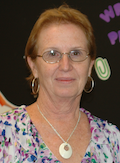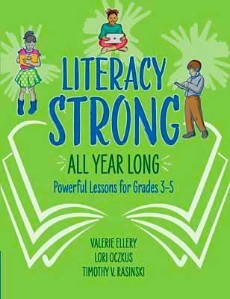A Year of Literacy Lessons for Grades 3-5
Literacy Strong All Year Long: Powerful Lessons for Grades 3-5
By Valerie Ellery, Lori D. Oczkus, Timothy V. Rasinski
(ASCD, 2018 – Learn more)

What exactly is literacy? To quote the authors, “Literacy is at the heart of all learning! It comprises reading, writing, listening, speaking and language competencies. Just like a heart is the most essential organ, pumping the vital necessities to all other areas of the body, literacy is the essential component that propels learning in all other content areas to function properly and bring lifelong learning.” (p xi)

Along with this huge responsibility, you need to bring that lifeline to your students in a way that meets their needs, helps them make connections, and provides lessons that challenge and reach various learning styles, while keeping their interests in this ever-advancing technological world!
Literacy learning is about connections: a network of paths. Just like veins that reach other parts of the body, literacy is the vein that reaches the other areas of the educational body: science, math, social studies, the arts, critical thinking to name a few!
I like to compare this book to an artichoke. (Yes, an artichoke.) Once you peel one layer, there is another layer, and each layer is just as delicious and leads to the heart! As you read each section, you will be excited and inspired to try the lessons, adapt them to your students’ needs, and probably begin to supplement the lessons with some extensions of your own.
The format of the book is perfect because it is written with the entire school year in mind. Authors Valerie Ellery, Lori D. Oczkus, and Timothy V. Rasinski provide a guide you can use from the first day of school until the last day – and they even include hints and lessons on how to help avoid the “summer slide.” The lessons all include a focus on applying the English Language Arts Literacy standards.
From “lesson trailer” to “evaluation”
I love the features of each lesson. Each plan begins with a “lesson trailer,” just like a movie trailer. You, the audience, get a brief glance into the purpose of the lesson and (believe me) get drawn into the exciting features of each lesson plan.
Next, is the “literacy enhancer” which is an overview of how each lesson can strengthen literacy in one of the reading areas: word work, vocabulary, fluency, and comprehension.
After that is the “preparation” section which outlines exactly what you need to prepare the lesson. “Initiation” follows with ideas on how to hook your students.
Of course, you need the “demonstration” section — the teacher models with think alouds or real time examples.
“Collaboration” is the section that allows students a chance to work together with peers before the “application” section where students work either with peers or independently to apply what they’ve learned.
I loved the “reflection” phase where students monitor their own learning. Teachers will be excited to be able to use the “adaption and extension” section (and may add some of their own ideas to the lessons as they apply them in the classroom).
Finally comes “Evaluation” or your “I can…” statements and behavior indicators.
Planning to limit “summer slide”
We’ve all heard about the “Summer Slide.” Based on research, students who do not continue to read during the summer are more likely to regress in their reading achievement. (Allington & McGill-Franzen, 2013; Kim and White, 2011) The final chapter focuses on how to help the parents of your students make reading a pleasure during the summer and not a daily chore that students will try to avoid.
Think about it. Your class loved reading in the classroom. Why don’t they continue to love it at home? This chapter is packed with ideas to keep them reading during the summer such as:
- Family Game Night
- Parent and Partner Reading
- Captioned TV
- Family Read-Alouds
- “You’ve got Mail!” snail mail or electronic email
- Community resources
- Summer Word Ladders
This book is truly a treasure and worth the investment. It’s crammed with so many ideas and resources that you will want to try each one. It’s going to be a “go to” book for the rest of your teaching life.
A year of gradual release
The lessons are designed to carefully look at the literacy standards and apply them to your teaching. The lessons guide teachers in their daily practice but also apply the gradual release model, giving the responsibility to students so they can be self-regulated learners and literacy strong!
Staying up to date on the best books for teachers is a challenge for any busy professional. This book is an essential item on the bookshelf of every teacher.
After teaching fourth graders for many years, Linda Biondi is supervising preservice and student teachers at The College of New Jersey and Rider University. Last summer she co-facilitated a week-long writing institute in conjunction with the National Writing Project at Rider University. She volunteers for two service organizations: Homefront and Dress for Success of Central New Jersey – both have a mission to end poverty and homelessness. The mission of Dress for Success is to empower women to achieve through economic independence.

































